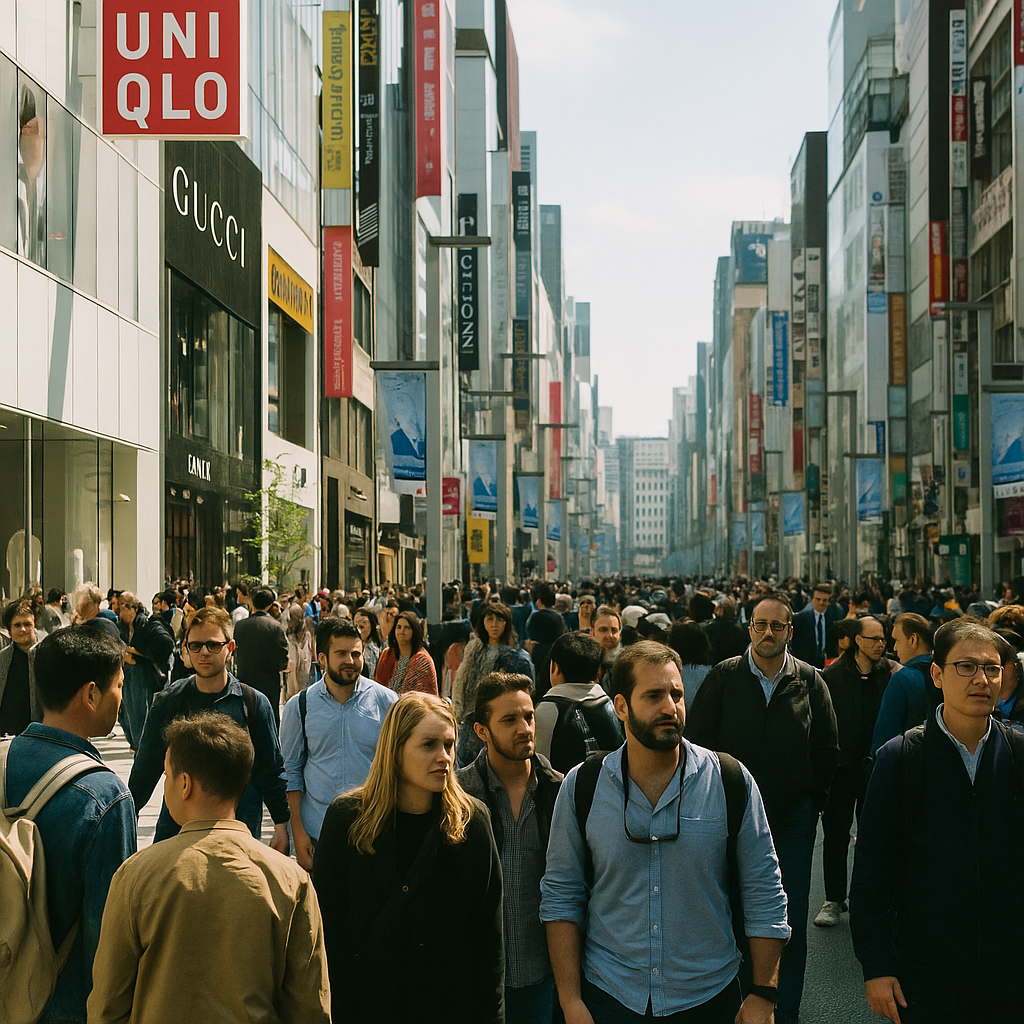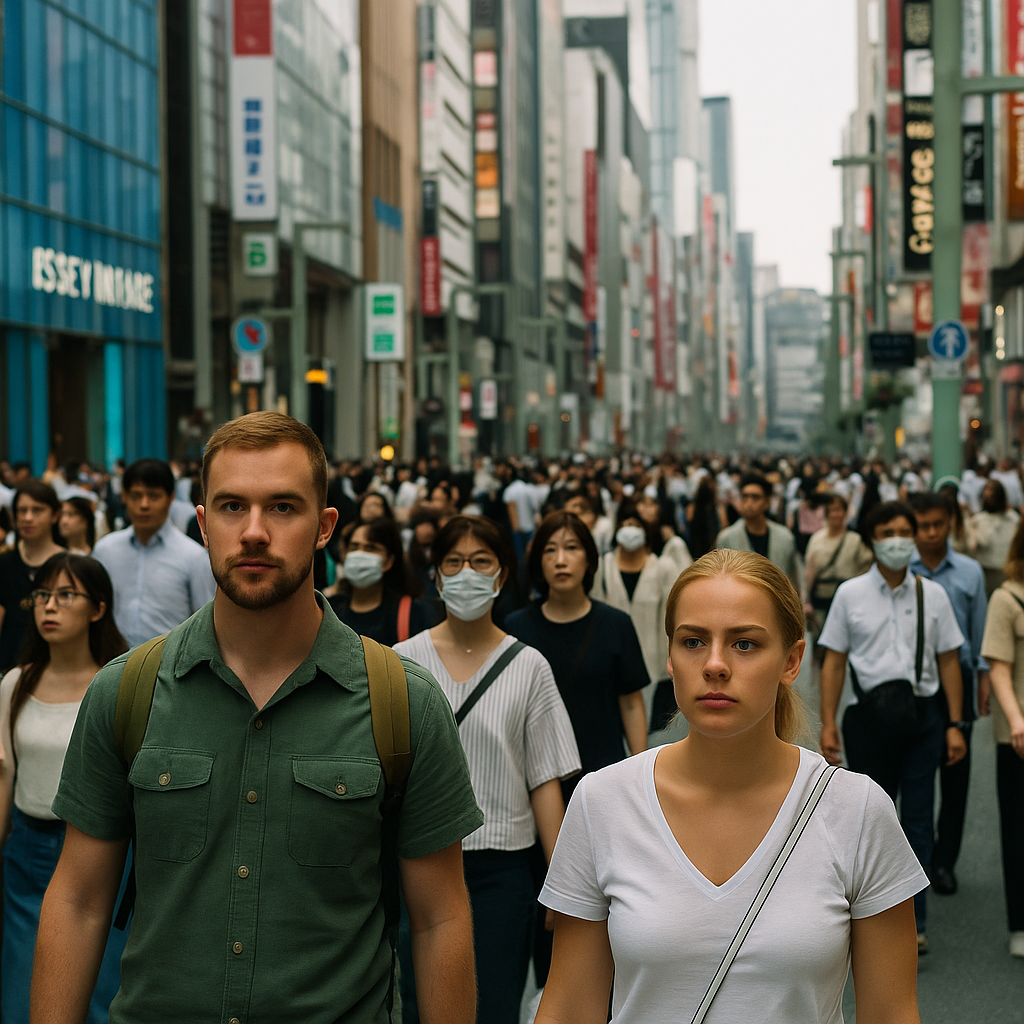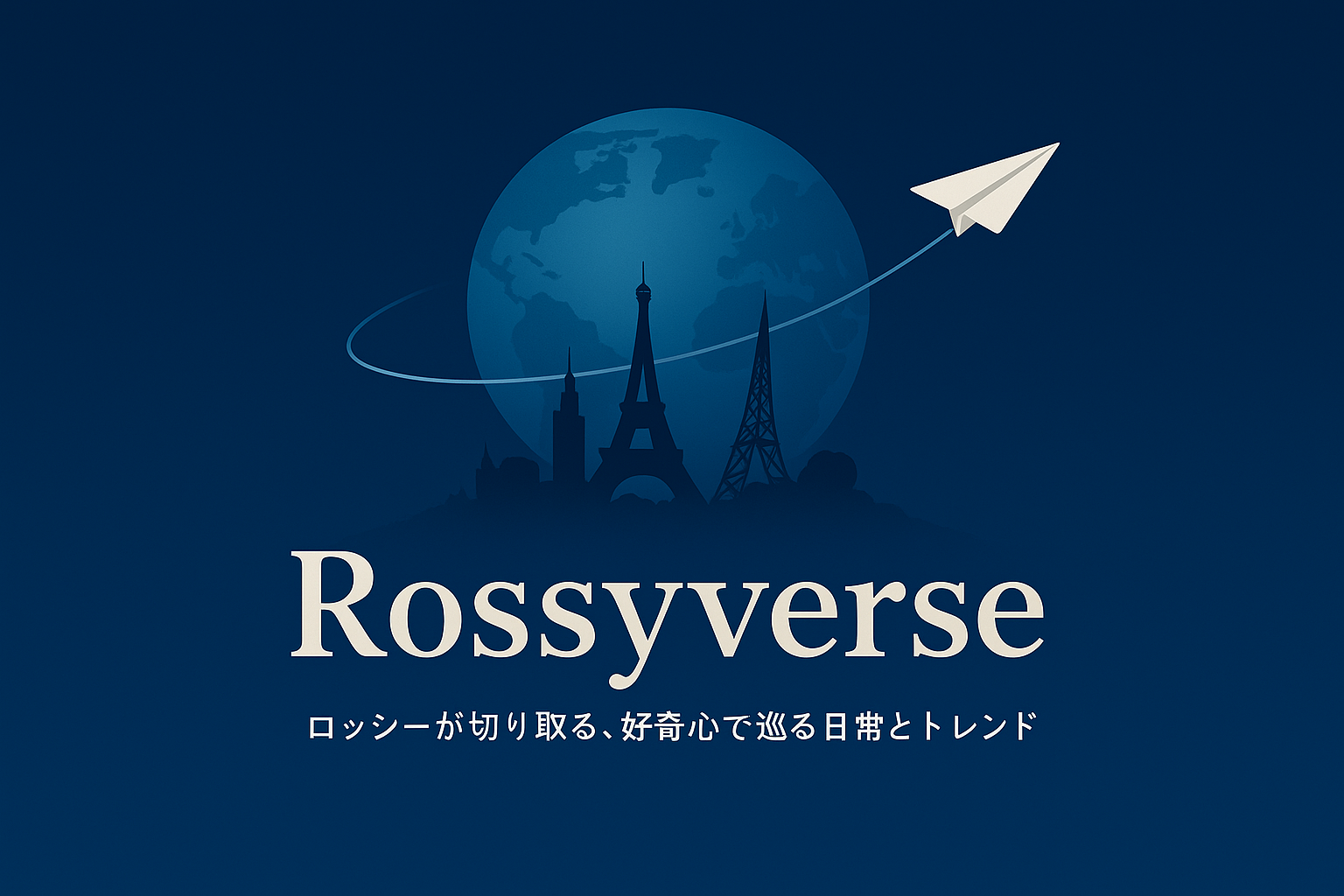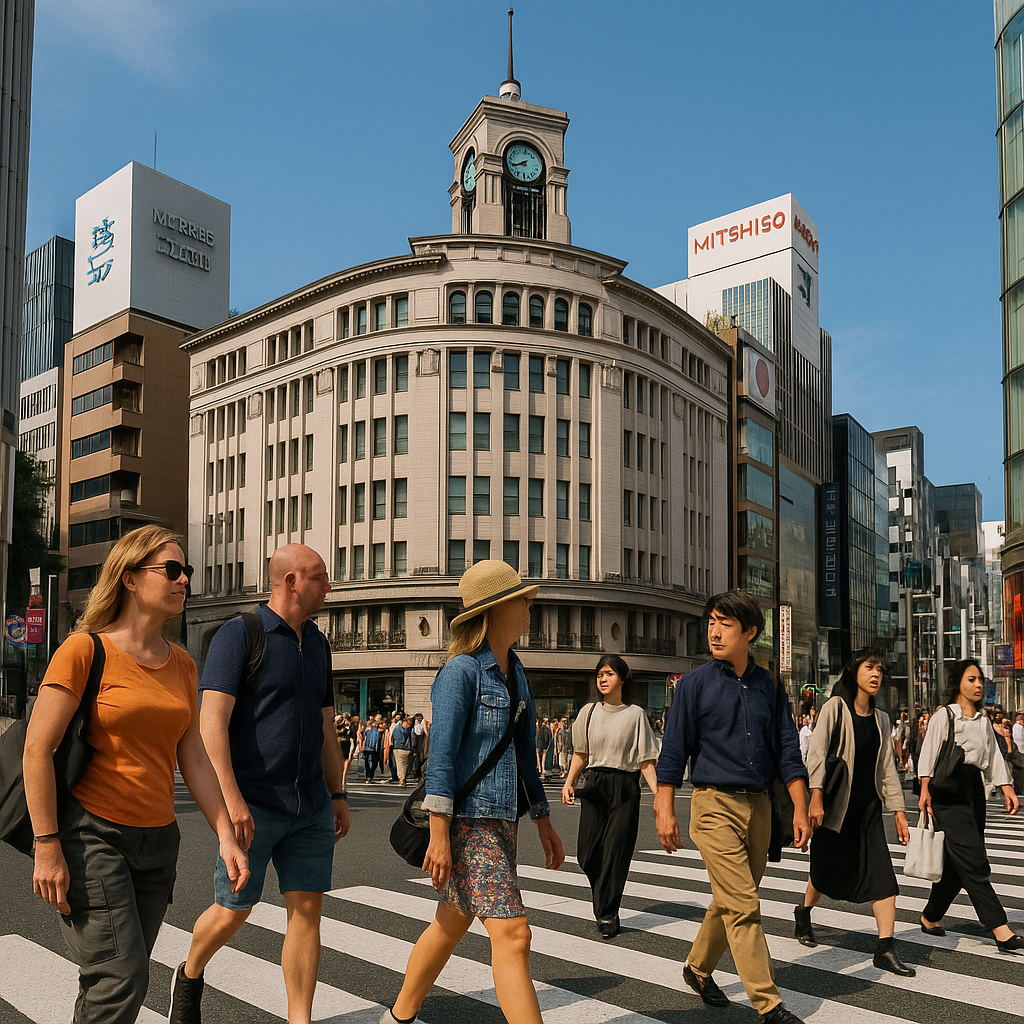久しぶりの銀座へ行ってきました。相変わらずの賑わいで、その人の勢いに圧倒されちゃいそうでした。それでもさすが日本でも有数の商業地域だけあって、郊外のベッドタウンで生活していると少し気後れしつつも、渋谷や新宿とは違う「大人の落ち着き」を感じる街であることは変わらなくて、どこか安心しました。
銀座はかつて――もう30年も前になりますが、数年間オフィスがあった場所です。当時の僕にとって銀座は「憧れの職場」であり、同時に「日常」でもありました。昼休みに同僚と早足で食堂へ向かったこと、たまに背伸びして老舗の喫茶店でナポリタンやクリームソーダを楽しんだこと。雨の日はビルの谷間にアスファルトの匂いが立ち、夜になると街全体が柔らかな光に包まれて、仕事帰りの足取りを少しだけ軽くしてくれたことをよく覚えています。
忘れられないのが、銀座三丁目の昭和通り近く、細い路地にあった小さなお弁当屋さん。老夫婦が二人で切り盛りしていて、派手さはないけれど、とにかくご飯が美味しい。唐揚げや煮物は家庭の味そのもので、しかも値段が良心的でした。昼時はいつも行列ができ、12時半にはすっかり売り切れ。だから少し早めに会社を出て買いに行ったり、直行の帰りに寄って、オフィスでゆっくり食べたり。華やかな街の喧騒の中に、ああいう温かさが確かに息づいていたことを思い出すと、銀座はただの商業の街ではなく、人の営みが積み重なってきた場所なんだと感じます。
当時から銀座は日本有数の商業地域として輝いていました。五丁目・鳩居堂さんの前の一角は「日本一の地価」として象徴的に語られ、土地の話題に必ず登場する場所でした。いまも街の景色は建て替えで大きく変わりましたが、昔からの看板を守る飲食店や小さな店が今も残っていて、時間の層が重なって見える瞬間があります。新しさを取り込みながら、過去を丁寧に抱え続ける――それが銀座の魅力の一つなのでしょう。
二年前に訪れたときは「変わらないなぁ」と思いながら歩いたのですが、今回は様子が違いました。賑わい方が明らかに変わっていたのです。人の流れや足早な歩調は以前のままなのに、よく見ると、すれ違う人の半分以上が外国の方。ニュースでインバウンド回復の話は聞いていましたが、目の前で体感すると驚きは大きい。耳を澄ますと、英語、中国語、韓国語、フランス語……さまざまな言葉が混じり合い、街の空気に別のリズムが加わっていました。

あるコンビニの窓越しに見えたイートインスペースは、窓際のカウンターがずらりと埋まっていて、多くが観光客らしき方々。日本人はあまり使わない印象の場所でも、文化が違えば自然な使い方になる――そんな当たり前のことに、改めて気づかされます。銀座がいま、「高級ショッピングの街」を超えて「世界が交差する舞台」になっていることを、身体で理解した瞬間でした。
これだけ多様な人々が集うなら、互いに気持ちよく過ごせる工夫が必要だとも思います。街角の案内表示をわかりやすくする、店舗で小さなマナー案内を添える、必要に応じて多言語で情報を届ける。日本らしい「おもてなし」を大切にしながら、守ってほしいことははっきり伝える。その両立ができれば、誤解や戸惑いは減っていくはずです。時には、迷っている人に一言そっと声をかけるだけでも、街の雰囲気は少し柔らかくなるのかもしれません。

季節ごとに銀座は違う顔を見せます。冬は並木道のイルミネーションが冷たい空気をきらりと照らし、春は街路樹が柔らかな緑をまとう。夏の夕方には汗ばむ腕に風が抜け、秋になると色調が落ち着いて、ショーウィンドウの灯りが一段と映えます。大通りの眩しさも好きですが、一本裏の路地に入ると、古い看板や磨りガラスの扉が今も息をしていて、時間の流れが急にゆっくりになる。銀座は、季節や時間帯や歩くルートで印象が変わる「再発見の街」でもあります。
歩いていると、過去の自分と今の自分が重なる瞬間が必ずあります。オフィスで必死に働いていた頃の記憶と、今こうして一歩引いた視点で街を眺める自分。そのどちらも僕にとって大切で、この街はいつも「人生の節目」を思い出させてくれる場所です。背筋が少し伸び、気持ちがリセットされる。そんな作用を、銀座は今も持ち続けています。
そして、不意に思うのです。次に来たとき、あのお弁当屋さんはどうしているだろう、と。もしもう店がなかったとしても、昼休みに行列に並んだ時間や、温かいおかずの匂い、紙袋の手触りは、僕の中の銀座を確かに形づくっています。街は変わり続けるけれど、記憶が連れてきてくれる風景は、意外なほど鮮やかに残るものですね。
銀座という街は、僕にとって東京で一番輝いている場所です。今も昔も、あの街には夢がある。そこに集う人々のエネルギーが、店の灯りと混ざり合って、街全体を静かに押し上げているように感じます。これからも銀座が、多様な人々にとって心地よい舞台であり続けますように。そして、昔を知る僕のような人間にとっても、変わらないときめきをそっと手渡してくれる街でありますように。次に歩くときは、家族や友人を連れて、また新しい銀座を見つけたい――そんな気持ちで、昨日の帰り道をゆっくりたどりました。
🔗 あわせて読みたい記事
・小さな想いが、社会を動かす — 僕とSDGsの歩み
SDGsへの個人的な取り組みと社会とのつながりを振り返った記事。
・豊かな国の、見えない貧困 ― SDGsと僕たちができること
日本に潜む「見えない貧困」と、僕たちにできることを考える記事。
What I Noticed Walking Through Ginza — The Past and Present of a City Overflowing with Foreign Visitors
I recently visited Ginza after a long time. The hustle and bustle was as overwhelming as ever, and I almost felt swept away by the flow of people. Still, as one of Japan’s most renowned commercial districts, it retains an atmosphere of sophistication that makes me feel a little out of place coming from a suburban commuter town, yet also reassures me with its sense of maturity that differs from Shibuya or Shinjuku.
Ginza was once my workplace—though it was more than 30 years ago, I spent several years in an office there. At the time, Ginza was both a place of “admiration” and part of my daily life. I remember hurrying out with colleagues during lunch breaks, eating at bustling cafeterias, and occasionally treating myself to old cafés with nostalgic spaghetti or cream soda. On rainy days, the asphalt between tall buildings carried a particular scent, and at night, the city was wrapped in a soft glow that lightened my steps on the way home.
One of my fondest memories is of a small bento shop in a back alley near Showa-dori in Ginza 3-chome. It was run by an elderly couple and had no flashy features, but the food was simple and delicious. The fried chicken and simmered dishes tasted like home cooking, and the prices were very reasonable. There was always a line at lunchtime, and everything was sold out by 12:30. So I would sometimes leave the office a bit early to get one, or stop by on the way back from an errand to bring it back and eat at my desk. Thinking of such warm places tucked into the midst of Ginza’s bustle reminds me that the area has never been just about commerce—it has always carried the everyday lives of ordinary people too.
Even back then, Ginza shone as one of Japan’s top commercial centers. The block in front of Kyuukyodo in 5-chome has long been known as the spot with the highest land value in the country, a symbol of the district’s prestige. Today, the skyline has changed with new buildings, but several long-standing restaurants and shops still remain, showing the layered history of the place. That ability to embrace the new while quietly preserving the old is one of Ginza’s unique charms.
When I visited two years ago, I thought, “It hasn’t changed much.” But this time, something was different. The flow of people looked the same, yet when I paid closer attention, I realized that more than half of those passing by were foreigners. I had heard on the news about the recovery of inbound tourism after the pandemic, but to see it with my own eyes was astonishing. It felt like more than 50% of the crowd, and when I added in those whose backgrounds weren’t obvious by appearance—especially some Asian visitors whose mannerisms clearly stood out—the percentage might have reached nearly 70%. Hearing so many languages—English, Chinese, Korean, French—intertwined on the streets gave Ginza a whole new rhythm.

At one convenience store with large glass windows, I noticed the eat-in space was full, almost entirely with tourists. Japanese people don’t often use those counters, but seeing them filled so naturally by others from different cultures reminded me of how habits differ. It was a striking moment of realizing that Ginza is no longer only a high-end shopping district—it has become a true stage where the world intersects.
With such diversity, I believe the city needs thoughtful preparation to ensure harmony. Clearer signage, small notices about manners in shops, or multilingual information could go a long way. Japan’s spirit of hospitality is important, but it should be balanced with a firm expectation that visitors respect local customs. Being too lenient will not solve problems, but blending kindness with clarity could help everyone enjoy the city more comfortably.

Ginza also changes with the seasons. Winter brings glittering illuminations down the tree-lined avenues. In spring, fresh greenery softens the cityscape. Summer evenings carry a warm breeze that cuts through the heat, and autumn lends a calm tone that makes the shop windows glow more vividly. The main avenues are dazzling, but just a step into the side alleys reveals old signboards and frosted glass doors, remnants of another era that make time flow more slowly. Ginza is a place of “rediscovery,” where the impression shifts with the season, the hour, or even the chosen path.
As I walk, past and present selves overlap. The younger me, working furiously in an office, and the current me, looking at the city with more distance. Both are precious, and Ginza always reminds me of these life stages. The city makes me stand a little taller, helps me reset, and offers perspective. That is something Ginza has never lost.
Sometimes I wonder what has become of that little bento shop. Perhaps it no longer exists. Yet the memory of lining up in the lunch rush, the aroma of warm food, and the feel of the paper bag in my hand remain vivid. Cities change, but memory carries its own landscapes, more enduring than I might expect.
For me, Ginza is the most radiant place in Tokyo. It has always held a kind of dream. The energy of the people mingles with the glow of shop lights, lifting the whole city quietly upward. I sincerely hope Ginza never loses its vitality, that it continues to welcome people from all over the world while still handing down a quiet sense of wonder to those who knew it before. Next time, I would like to bring family or friends and discover yet another new Ginza together.
🔗 Related Articles
・Small Hopes Move Society — My Journey with the SDGs
A reflection on my personal engagement with the SDGs and its link to society.
・Invisible Poverty in a Wealthy Nation — What We Can Do Together
An exploration of hidden poverty in Japan and what individuals can do to help.




コメント